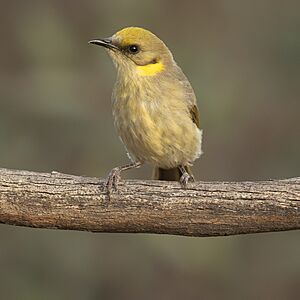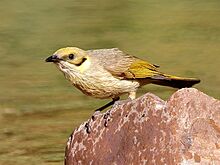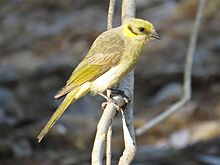Grey-fronted honeyeater facts for kids
Quick facts for kids Grey-fronted honeyeater |
|
|---|---|
 |
|
| Yathong Nature Reserve, NSW | |
| Conservation status | |
| Scientific classification | |
| Genus: |
Ptilotula
|
| Species: |
plumula
|
| Synonyms | |
|
|
The grey-fronted honeyeater (Ptilotula plumula) is a small, active bird. It belongs to the Meliphagidae family, which are often called honeyeaters. This bird is special because it is endemic to Australia. This means it is found only in Australia and nowhere else in the world.
These honeyeaters like to live in places with Mediterranean-type shrubby plants. This kind of habitat has tough, often spiky bushes and small trees. The grey-fronted honeyeater was first described in 1841. A famous English bird expert named John Gould gave it its first scientific name. Later, in 2011, scientists used new methods like molecular phylogenetic analysis (studying DNA) to learn more about bird families. They found that this bird belonged in a different group, or genus, called Ptilotula.
What Does It Look Like?
The grey-fronted honeyeater is a small bird. It has a simple look, but also some cool features. One of its most noticeable features is a bright yellow feather tuft on its neck. This tuft is outlined with black feathers above it.
This bird gets its name from a small grey patch on its forehead. This patch can sometimes be hard to see, especially on birds living in northern Australia. Its head feathers are a mix of olive and yellow. The area around its eyes, called the lores, is blackish. The top part of its body is olive-grey, and its flight feathers have a yellow-olive color. The feathers on its belly are off-white with faint stripes.
Spotting the Grey-fronted Honeyeater
It can be tricky to tell the grey-fronted honeyeater apart from another bird, the yellow-tinted honeyeater. This is because they are similar in size. Also, they live in some of the same areas.
But there are a few differences to look for. The yellow-tinted honeyeater has yellow-grey lores (around its eyes). Its neck plumes are also thinner than those of the grey-fronted honeyeater. Learning these small details can help you identify them correctly!
Gallery





